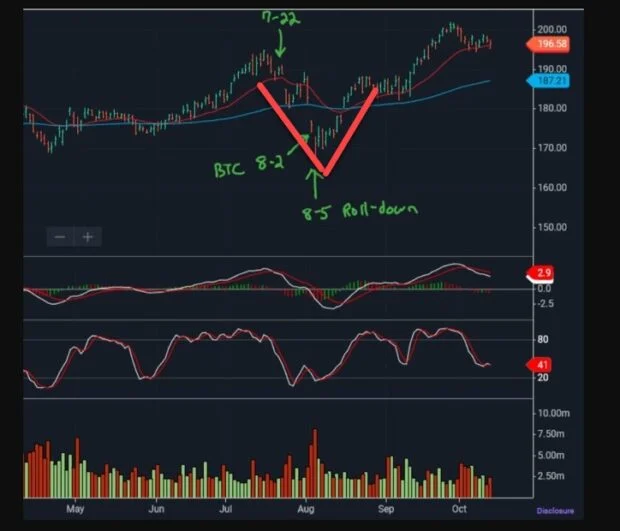How to Improve Results for a Rolling-Down Covered Call Trade – March 24, 2025
Rolling down is a frequently used covered call writing exit strategy to mitigate when share price declines. The original sold option is closed (bought back), while simultaneously opening another at a lower strike in the same contract cycle. When share price drops, the value of the associated call option will also fall by its Delta amount. As one example, if the original call option was sold for $2.00 per-share and had a Delta of 50, a $1.00 decrease in the share price will result in a $0.50 drop in option value, to $1.50.
Real-life trade with The Consumer Discretionary Select Sector SPDR Fund (NYSE: XLY)
- 7/22/2024: Buy 200 x XLY at $188.94
- 7/22/2024: STO 2 x 8/16/2024 $189.00 calls at $4.30
- 8/2/2024: BTC 2 x 8/16/2024 $189.00 calls at $0.46 (20% guideline triggered while share price gapped-down)
- 8/5/2024: STO 2 x 8/16/2024 $168.00 calls at $6.40 (rolled-down from the $189.00 strike to the $168.00 strike)
Had the shares (and overall market) not gapped-down, the short call could have been closed at the 20% limit order of $0.86).
6- month Price chart of XLY during this contract cycle

- The chart shows the point of the roll-down and subsequent share price recovery (red V-shaped pattern)
- This is classic for hitting a double, but since it occurred at the start of the 2nd have of the contract, rolling-down was appropriate
- I’m not sure which exit strategy I would have opted for, but I won’t challenge rolling-down
Which rolling-down strike should be selected?
- My preference is to always roll-down to an OTM strike, thereby allowing for some share price recovery
- If we were bearish on price performance moving forward (after the gap-down), we should sell the ETF
- By selling the $168.00 strike, we are locked into a huge loss of share value, despite the nice premium return
- On 8/5/2024, XLY was trading at about $174.00, meaning a deep ITM call was the selected rolling-down strike
- Let’s have a look at rolling-down to an OTM strike on 8/5/2024
XLY option-chain on 8/2/2024

- Sorry this chart is difficult to read
- The $180.00 8/16/2024 OTM call had a bid price of $2.45
- This would result in a rolling-down net option credit of $1.99 per-share
- The $180.00 strike allows share appreciation from $174.00 to $180.00 if there is recovery (there was)
- If share price continued to decline, another rolling-down trade could have been initiated, or shares could have been sold at a managed loss
Final trade results when rolling-down to the $168.00 ITM call
- Realized share loss: $20.94 per-share ($188.94 – $168.00)
- Net option credit: $10.24 ($4.30 – $0.46 + 6.40)
- Final realized trade loss: $10.70 per-share (-$20.94 + $10.24)
Final trade results when rolling-down to the $180.00 ITM call
- Realized share loss: $894 per-share ($188.94 – $180.00)
- Net option credit: $6.29 ($4.30 – $0.46 + 2.45)
- Final realized trade loss: $2.65 per-share (-$8.94 + $6.29
Discussion
Rolling-down is a viable exit strategy opportunity when share price declines in the latter half of a monthly contract (or weekly contracts, as well). If we are still bullish on the underlying security, we should roll-down to an OTM strike and receive a net option credit and preserve the opportunity for some share price recovery. If we are bearish on the stock or ETF, we can sell it and move on to a better performer.
Author: Alan Ellman